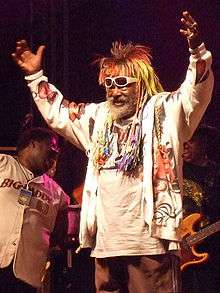Psychedelic funk
Psychedelic funk (also called funkadelia or conflated with psychedelic soul[1]) is a music genre that combines funk music with elements of psychedelic rock.[3] It was pioneered in the late 1960s and early 1970s by acts like Sly and the Family Stone, Jimi Hendrix, and the Parliament-Funkadelic collective.[3][4] It would influence later styles including '70s jazz fusion and the '90s West Coast hip hop style G-funk.

| Psychedelic funk | |
|---|---|
| Other names | |
| Stylistic origins | |
| Cultural origins | Late 1960s |
| Derivative forms | |
| Fusion genres | |
| Other topics | |
| Psychedelic music | |
History
Following the late 1960s work of Jimi Hendrix, the music and drug culture of psychedelia began to have a widespread impact on African American soul and funk musicians.[5] Black funk artists such as Sly and the Family Stone borrowed techniques from psychedelic rock music, including wah pedals, fuzz boxes, echo chambers, and vocal distorters.[3] Producer Norman Whitfield would draw on this sound on popular Motown recordings such as The Temptations' "Cloud Nine" and Marvin Gaye's "I Heard It Through the Grapevine."[4] In 1970, Hendrix formed the short-lived trio Band of Gypsys, described as "ground zero" for psychedelic funk.[6] By the early 1970s, the main elements of psychedelic funk were adopted as signifiers of "urban blackness" and incorporated into blaxploitation films.[1]
In the 1970s, groups such as Parliament-Funkadelic developed this sensibility, employing synthesizers and acid rock-oriented guitar work into open-ended funk jams.[4][3] Led by George Clinton, P-Funk would shift the genre away from song-form and toward groove and texture, emphasizing the abject elements of psychedelia in contrast to earlier artists, according to theorist Kodwo Eshun.[1] The 1970s group War (with singer Eric Burdon) recorded in a psychedelic funk-rock style featuring prominent rhythm and horn sections, bass lines, and drum breaks, as well as lyrics protesting racism and police brutality.[7] The 1974 album Inspiration Information by Shuggie Otis explored psychedelic funk and later received acclaim when it was reissued by David Byrne's Luaka Bop label.[8]
West African groups such as Blo and Orchestre Poly-Rythmo de Cotonou played forms of psychedelic funk in the mid 1970s, both drawing on the Afrobeat of Nigerian musician Fela Kuti.[9][10] A collection of 1970s psychedelic funk recordings from Ghana and Togo was released in 2010 as Afro-Beat Airways: West African Shock Waves by the Analog Africa label.[11] Music from Nigeria's 1970s psychedelic funk scene was later documented on the compilation Wake Up You! The Rise & Fall of Nigerian Rock 1972-1977, released in 2016.[12]
Influence
In the early 1970s, jazz artists such as Miles Davis and Herbie Hancock combined elements of psychedelic funk with urban jazz to pioneer jazz fusion.[13][14] Subsequent artists would be influenced by the style including Prince.[4] New wave band Talking Heads explored psychedelic funk, influenced by George Clinton, on a trilogy of acclaimed albums in the late 1970s.[15][16]
In the 1990s, the popular psychedelic funk style known as G-funk emerged from the West Coast hip hop scene, represented by Warren G, Dr. Dre, and Snoop Dogg.[17] Many G-funk recordings sampled tracks by earlier psychedelic funk bands, most prominently Parliament-Funkadelic.[17] The 1990s hip hop duo OutKast were also influenced by black psychedelic musicians such as Sly Stone and Clinton.[18]
Examples of psychedelic funk from world music scenes have been collected on compilations issued on the World Psychedelic Funk Classics label.[19] The 2016 album Awaken, My Love! by Childish Gambino borrowed the psychedelic funk sound of Clinton and Bootsy Collins, with Vice negatively describing it as "pure Funkadelic cosplay."[20]
See also
- Funk
- Psychedelic music
- Psychedelic culture
References
- Echard, William (2017). Psychedelic Popular Music: A History through Musical Topic Theory. Indiana University Press. pp. 123–125. ISBN 9780253026590. Retrieved 26 January 2018.
- Lauren Cochrane, "George Clinton: the best dressed man in music", The Guardian, June 23, 2008.
- Scott, Derek B. (2009). Dayton Street Funk: The Layering of Musical Identities. The Ashgate Research Companion to Popular Musicology. p. 275. ISBN 9780754664765. Retrieved 25 November 2016.
- Edmondson, Jacqueline (2013). Music in American Life: An Encyclopedia of the Songs, Styles, Stars, and Stories that Shaped our Culture [4 volumes]: An Encyclopedia of the Songs, Styles, Stars, and Stories That Shaped Our Culture. ABC-CLIO. p. 474.
- "Psychedelic soul", Allmusic, retrieved 27 February 2017.
- Drozdowski, Ted. "Remembering Jimi Hendrix: His Top 10 Live Recordings". Gibson. Retrieved 9 May 2020.
- Goldsmith, Melissa Ursula Dawn (2019). Listen to Classic Rock! Exploring a Musical Genre. ABC-CLIO. p. 59.
- Mirkin, Steven. "Reviews: Shuggie Otis". Variety. Retrieved 5 April 2020.
- Staff. "Africa 100: The Indestructible Beat". Pitchfork. Retrieved 5 April 2020.
- Thomas, Andy. "Reviews: Orchestre Poly-Rythmo de Cotonou". The Quietus. Retrieved 5 April 2020.
- Kazbek, Katya. "Music: Afro-Beat Airways, West African Shock Waves: Ghana & Togo 1972-1978, 2010". SupaModu. Retrieved 5 April 2020.
- Killakam. "The Best 1970s Nigerian Psychedelic Funk Gets Compiled In 'Wake Up You! The Rise & Fall Of Nigerian Rock'". OkayAfrica. Retrieved 5 April 2020.
- Lien, James (September 1997). "In the Bins". CMJ New Music Monthly (49). CMJ Network.
- Dean, Matt (December 29, 2011). The Drum: A History. Scarecrow Press. p. 292.
- Reynolds, Simon (2005). Rip It Up and Start Again: Postpunk 1978-1984. Penguin. p. 163.
- Bowman, David (2009). This Must Be the Place: The Adventures of Talking Heads in the 20th Century. Harper Collins.
- Hunter, Christopher. "WARREN G IS RELEASING A DOCUMENTARY ON THE HISTORY OF G-FUNK". XXL Mag. Missing or empty
|url=(help) - "Outkast". Rolling Stone.
- All Music Various Artists, Psych-Funk Sa-Re-Ga! Seminar: Aesthetic Expressions of Psychedelic Funk Music in India 1970-1983, AllMusic Review by John Bush
- Daramola, Israel. "Can Funk Give Childish Gambino What He Needs?". Vice. Retrieved 5 April 2020.